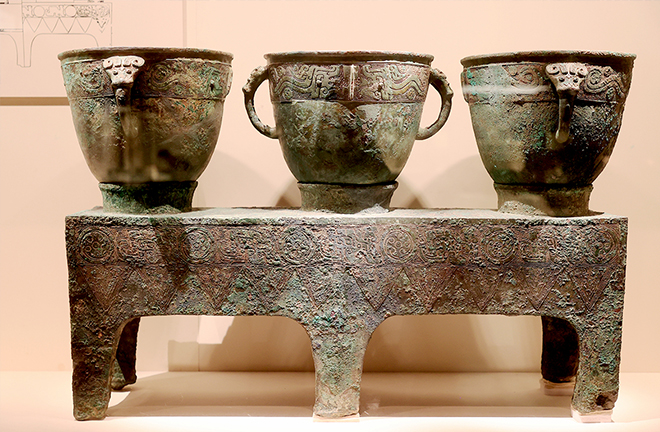Pre-Qin history studies blossom

A Shang Dynasty (c. 16th–11th century BCE) bronzeware set, displayed in the National Museum of China in Beijing Photo: CFP
Since the China Pre-Qin History Society was established in 1982, scholars of pre-Qin (before 221 BCE) history have had 40 years of abundant achievements.
Research centers
In May 1982, pre-Qin historians witnessed the founding of the China Pre-Qin History Society in Chengdu, Sichuan Province. Historian and paleographer Xu Zhongshu served as the first president. The first issue of the journal Research Trends of Pre-Qin History from the China Pre-Qin History Society was published in 1983, which clearly recorded relevant information from the society’s founding meeting and first annual meeting, and introduced the academic career and representative achievements of predecessor scholars, such as Xu Zhongshu and Jin Jingfang. Historians such as Li Xueqin wrote about overseas research on pre-Qin history. Academic research from important research hubs of pre-Qin history, such as the Chinese Academy of Social Sciences (CASS), Sichuan University, Northeast Normal University, and Northwest University, was also shown.
In the recent three years, these hubs in different regions have strengthened the study of pre-Qin history from different angles. CASS has been equipped with a strong research force in the field, with remarkable achievements in pre-Qin history and archaeology. Sichuan University has established the Center for Research on Paleography and Pre-Qin History. Northeast Normal University has organized the First Frontier Forum on Chinese Pre-Qin History, focusing on frontier issues including new theories, new methods, and new materials. The Institute of Chinese Thoughts and Culture at Northwest University and the China Pre-Qin History Society co-organized a special seminar on the history of pre-Qin thought and culture.
Sichuan University has a substantial academic background in the field of paleography and pre-Qin history. In November 2019, a forum, with the theme of “Center and Periphery: the Bashu Culture, and Early Ancient China,” was held in Chengdu, Sichuan Province. At the forum, the Center for Research on Paleography and Pre-Qin History of Sichuan University was inaugurated, which has continuously promoted the development of paleography, pre-Qin history, and other “niche” disciplines, gaining mounting academic achievement and influence.
Liu Yuan, director of the pre-Qin history research office of the Institute of History at CASS, explained that the office was established under the direct care of Guo Moruo, who was then president of the Chinese Academy of Sciences. Many historians such as Gu Jiegang, Hu Houxuan, and Li Xueqin undertook and completed important academic tasks there.
Research topics and projects
Further theoretical discussion is necessary in the field of pre-Qin history, such as the origin of the state and civilization, oracle bone inscriptions and the Shang Dynasty (c. 16th–11th century BCE), the social forms and social natures of the Xia (c. 21th–16th century BCE), Shang, and Zhou (c. 11th century BCE–221 BCE) dynasties, and pre-Qin thought and culture.
According to Liu Yuan, The Collection of Oracle Bone Inscriptions is a landmark masterpiece from CASS, as well as the most competitive product and the most prominent keyword in the pre-Qin history research office. Oracle bone inscriptions in the collection should be further examined as historical materials of the Shang Dynasty and early Chinese cultural heritage, contributing to academic innovations through special research. Upgrades are needed on the basis of research methods and theoretical summary of oracle bone inscriptions and Shang Dynasty history.
Peng Bangben, director of the Center for Research on Paleography and Pre-Qin History at Sichuan University, said that the center wields the professional advantages of paleography and pre-Qin history to focus on four research directions: oracle bone inscriptions, pre-Qin history and comprehensive research on unearthed documents, Shang and Zhou bronze ware, and Bashu history. It is committed to promoting two major research projects: “a newly revised dictionary of oracle bone inscriptions” and “a study on the origin of Chinese civilization and the evolution of pre-Qin monarchy,” while accelerating the compilation and publication of The Complete Works of Xu Zhongshu.
As oracle bone research has made remarkable progress over the past 120 years, an in-depth summary is conducive to seeking a proper direction for future studies. The recent publication, Inheriting Chinese Cultural Genes: Paper Selection and Synopsis of Oracle Bone Studies Since its Discovery 120 Years Ago has attracted wide attention from academia. According to Liu Zhao, lead editor of the compilation and director of the Center for Research on Chinese Excavated Classics and Paleography at Fudan University, from over 10,000 papers published over the past 120 years, the series selects 120 that fully reflect the panorama of oracle bone studies and make academic contributions with innovative ideas.
Edited by YANG LANLAN

 PRINT
PRINT CLOSE
CLOSE